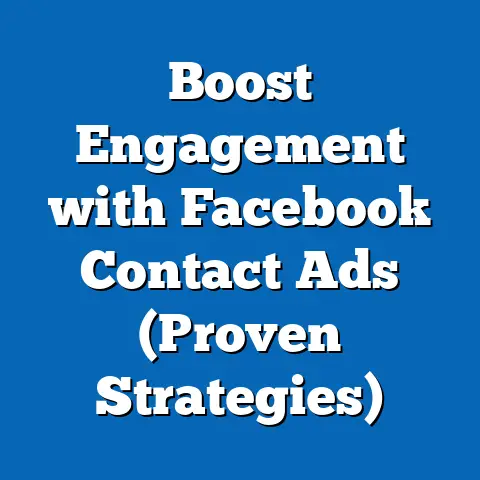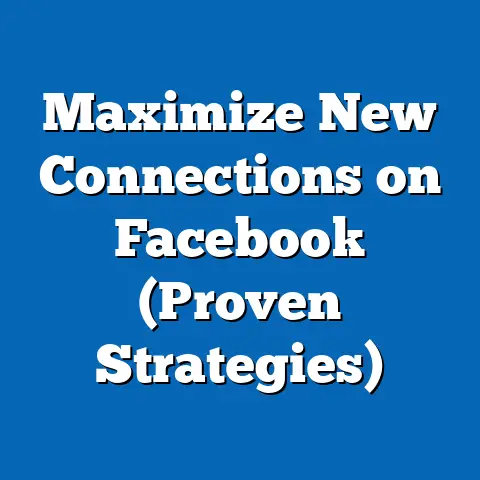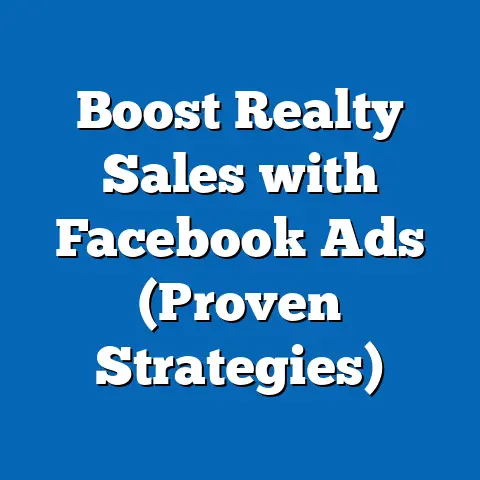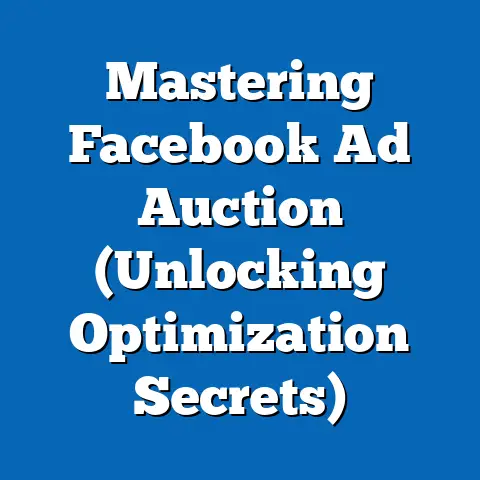Track Facebook Ad Start Dates (Essential Insights)
Facebook. It’s a name that’s practically synonymous with the internet itself. I remember when it first launched, a simple platform for college students to connect. Now, look at it – a global behemoth connecting billions and a powerhouse for businesses to reach their target audience. Over the years, I’ve watched Facebook evolve, adapt, and consistently remain a relevant player in the digital marketing game. One thing that hasn’t changed is the importance of strategic advertising on the platform.
Facebook Ads have become a cornerstone of countless marketing strategies. But simply throwing money at ads isn’t enough. To truly maximize your ROI, you need to dive deep into the data and understand the nuances of your campaigns. And one often overlooked, yet incredibly important, element is the tracking of your ad start dates.
Understanding when your ads begin running can unlock a wealth of information, leading to better insights, improved performance tracking, and ultimately, a more optimized ad spend. I’ve seen firsthand how meticulously tracking start dates can transform a struggling campaign into a roaring success. This article will delve into the essential insights you can gain by tracking your Facebook ad start dates and how to implement these strategies for your own campaigns.
1. The Importance of Tracking Ad Start Dates
Why should you care about the day your ad goes live? It might seem like a minor detail, but believe me, it’s anything but. The start date of your Facebook ad campaign can have a profound impact on its overall performance.
-
Seasonality and Trends: I’ve learned that timing is everything. Launching a summer clothing campaign in December? Probably not the best idea. Many businesses operate on seasonal cycles. Tracking your ad start dates allows you to align your campaigns with these cycles, capitalizing on peak demand and avoiding periods of low interest. For instance, a tax preparation service would likely see far greater success launching ads in January and February than in July. Similarly, staying abreast of trending topics and cultural events allows you to create timely, relevant ads that resonate with your audience. For example, I once ran a campaign for a local bakery that featured a limited-edition cake for Valentine’s Day. By carefully timing the ad launch a few weeks before the holiday, we generated significant buzz and drove a surge in sales.
-
Audience Engagement: Different demographics are active on Facebook at different times. I once worked with a client who targeted stay-at-home parents. We initially launched our ads during typical business hours, only to find our engagement was surprisingly low. After analyzing the data, we realized that these parents were most active on Facebook during the early morning hours (before the kids woke up) and in the evenings (after bedtime). By adjusting our ad scheduling to align with these peak activity times, we saw a dramatic increase in engagement and conversions. Tracking start dates allows you to identify these patterns and optimize your ad schedule accordingly. It also helps you understand how user behavior changes over time, which is crucial for long-term campaign success.
-
Budget Allocation: I’ve seen so many campaigns fail simply because the budget wasn’t allocated effectively. Starting your ads at the right time allows you to maximize your budget. If you know that engagement is typically higher on weekends, you can allocate a larger portion of your budget to those days. Conversely, if you see consistently low performance on certain days of the week, you can reduce your spend or even pause your ads during those periods. Tracking start dates provides the data you need to make informed decisions about budget allocation, ensuring that your money is working as hard as possible.
-
Analyzing Effectiveness Over Time: Running the same ad for months without analyzing its performance is a recipe for disaster. By tracking start dates, you can accurately assess how your ad strategy is performing over time. Are your click-through rates declining? Is your cost per acquisition increasing? These trends can signal that your ad is becoming stale or that your target audience is experiencing ad fatigue. Understanding these patterns allows you to make timely adjustments to your creative, targeting, or bidding strategy, keeping your campaign fresh and effective.
-
Optimal Posting Times: Years ago, I managed a campaign for a music festival. Our initial strategy was to run ads continuously, thinking that constant exposure would generate the most interest. However, we quickly realized that our engagement was inconsistent. After delving into the data, we discovered that our audience was most responsive to ads posted in the evenings, particularly on Thursdays and Fridays. By focusing our ad spend on these optimal posting times, we saw a significant increase in ticket sales. Tracking start dates helps you identify these golden windows of opportunity, allowing you to maximize your reach and impact.
Seasonality and Trends: I’ve learned that timing is everything. Launching a summer clothing campaign in December? Probably not the best idea. Many businesses operate on seasonal cycles. Tracking your ad start dates allows you to align your campaigns with these cycles, capitalizing on peak demand and avoiding periods of low interest. For instance, a tax preparation service would likely see far greater success launching ads in January and February than in July. Similarly, staying abreast of trending topics and cultural events allows you to create timely, relevant ads that resonate with your audience. For example, I once ran a campaign for a local bakery that featured a limited-edition cake for Valentine’s Day. By carefully timing the ad launch a few weeks before the holiday, we generated significant buzz and drove a surge in sales.
Audience Engagement: Different demographics are active on Facebook at different times. I once worked with a client who targeted stay-at-home parents. We initially launched our ads during typical business hours, only to find our engagement was surprisingly low. After analyzing the data, we realized that these parents were most active on Facebook during the early morning hours (before the kids woke up) and in the evenings (after bedtime). By adjusting our ad scheduling to align with these peak activity times, we saw a dramatic increase in engagement and conversions. Tracking start dates allows you to identify these patterns and optimize your ad schedule accordingly. It also helps you understand how user behavior changes over time, which is crucial for long-term campaign success.
Budget Allocation: I’ve seen so many campaigns fail simply because the budget wasn’t allocated effectively. Starting your ads at the right time allows you to maximize your budget. If you know that engagement is typically higher on weekends, you can allocate a larger portion of your budget to those days. Conversely, if you see consistently low performance on certain days of the week, you can reduce your spend or even pause your ads during those periods. Tracking start dates provides the data you need to make informed decisions about budget allocation, ensuring that your money is working as hard as possible.
Analyzing Effectiveness Over Time: Running the same ad for months without analyzing its performance is a recipe for disaster. By tracking start dates, you can accurately assess how your ad strategy is performing over time. Are your click-through rates declining? Is your cost per acquisition increasing? These trends can signal that your ad is becoming stale or that your target audience is experiencing ad fatigue. Understanding these patterns allows you to make timely adjustments to your creative, targeting, or bidding strategy, keeping your campaign fresh and effective.
Optimal Posting Times: Years ago, I managed a campaign for a music festival. Our initial strategy was to run ads continuously, thinking that constant exposure would generate the most interest. However, we quickly realized that our engagement was inconsistent. After delving into the data, we discovered that our audience was most responsive to ads posted in the evenings, particularly on Thursdays and Fridays. By focusing our ad spend on these optimal posting times, we saw a significant increase in ticket sales. Tracking start dates helps you identify these golden windows of opportunity, allowing you to maximize your reach and impact.
Takeaway: Tracking ad start dates is fundamental for understanding how timing influences campaign performance. It enables you to align with seasonal trends, optimize audience engagement, allocate your budget effectively, and analyze your ad strategy over time.
2. Tools and Methods for Tracking Start Dates
Now that you understand why tracking ad start dates is so important, let’s explore the tools and methods you can use to do it effectively. There are options for every budget and level of technical expertise.
-
Facebook Ads Manager: The most obvious place to start is with Facebook’s own Ads Manager. It’s the central hub for creating, managing, and analyzing your campaigns, and it offers built-in features for tracking campaign timelines. Within Ads Manager, you can easily view the start and end dates of each campaign, ad set, and individual ad. You can also filter your data by date range to see how your campaigns performed during specific periods.
- Pros: It’s free, readily available, and provides a comprehensive overview of your campaign performance.
- Cons: While Ads Manager provides basic tracking capabilities, it can be limited in terms of advanced analysis and reporting. For example, it doesn’t offer the same level of customization as third-party tools.
I recommend using Ads Manager as your primary tool for monitoring your campaigns. But don’t be afraid to experiment with other options to get a more detailed view of your data.
-
Third-Party Analytics Platforms: Several third-party tools offer enhanced tracking capabilities that go beyond what’s available in Ads Manager. These platforms often provide more detailed analytics, customizable dashboards, and advanced reporting features.
-
Google Analytics: While not directly integrated with Facebook Ads, Google Analytics can be used to track website traffic and conversions that result from your Facebook campaigns. By adding UTM parameters to your ad URLs, you can attribute website activity to specific Facebook ads. This allows you to see which ads are driving the most valuable traffic to your website and which ones are underperforming. I’ve found Google Analytics invaluable for understanding the full customer journey, from the initial ad click to the final conversion.
-
Social Media Management Tools: Tools like Hootsuite, Buffer, and Sprout Social offer features for tracking social media performance across multiple platforms, including Facebook. These tools can provide insights into engagement, reach, and audience demographics. While they may not offer the same level of detail as dedicated analytics platforms, they can be useful for monitoring your overall social media presence and identifying trends.
-
Dedicated Facebook Ads Analytics Tools: There are also tools specifically designed for analyzing Facebook Ads performance. These tools, such as AdEspresso and Revealbot, offer advanced features like automated reporting, A/B testing, and budget optimization. They can be particularly useful for businesses that are running large-scale Facebook ad campaigns.
-
-
Spreadsheets: Don’t underestimate the power of a simple spreadsheet. If you’re on a tight budget or prefer a more hands-on approach, you can easily track your ad start dates using a spreadsheet program like Microsoft Excel or Google Sheets. Create columns for campaign name, ad set name, start date, end date, budget, and key performance indicators (KPIs). Then, manually update the spreadsheet with your campaign data. While this method requires more effort, it allows you to customize your tracking system to meet your specific needs.
I started out using spreadsheets to track my campaigns. It wasn’t glamorous, but it was effective. It taught me the importance of meticulous data collection and analysis.
-
Reminders and Calendar Integrations: Sometimes, the simplest solutions are the most effective. Setting reminders in your calendar can help you stay on top of your ad start dates and ensure that you’re launching your campaigns at the right time. Most calendar apps allow you to set recurring reminders, so you can schedule regular check-ins to monitor your ad performance.
Facebook Ads Manager: The most obvious place to start is with Facebook’s own Ads Manager. It’s the central hub for creating, managing, and analyzing your campaigns, and it offers built-in features for tracking campaign timelines. Within Ads Manager, you can easily view the start and end dates of each campaign, ad set, and individual ad. You can also filter your data by date range to see how your campaigns performed during specific periods.
- Pros: It’s free, readily available, and provides a comprehensive overview of your campaign performance.
- Cons: While Ads Manager provides basic tracking capabilities, it can be limited in terms of advanced analysis and reporting. For example, it doesn’t offer the same level of customization as third-party tools.
I recommend using Ads Manager as your primary tool for monitoring your campaigns. But don’t be afraid to experiment with other options to get a more detailed view of your data.
Third-Party Analytics Platforms: Several third-party tools offer enhanced tracking capabilities that go beyond what’s available in Ads Manager. These platforms often provide more detailed analytics, customizable dashboards, and advanced reporting features.
-
Google Analytics: While not directly integrated with Facebook Ads, Google Analytics can be used to track website traffic and conversions that result from your Facebook campaigns. By adding UTM parameters to your ad URLs, you can attribute website activity to specific Facebook ads. This allows you to see which ads are driving the most valuable traffic to your website and which ones are underperforming. I’ve found Google Analytics invaluable for understanding the full customer journey, from the initial ad click to the final conversion.
-
Social Media Management Tools: Tools like Hootsuite, Buffer, and Sprout Social offer features for tracking social media performance across multiple platforms, including Facebook. These tools can provide insights into engagement, reach, and audience demographics. While they may not offer the same level of detail as dedicated analytics platforms, they can be useful for monitoring your overall social media presence and identifying trends.
-
Dedicated Facebook Ads Analytics Tools: There are also tools specifically designed for analyzing Facebook Ads performance. These tools, such as AdEspresso and Revealbot, offer advanced features like automated reporting, A/B testing, and budget optimization. They can be particularly useful for businesses that are running large-scale Facebook ad campaigns.
Google Analytics: While not directly integrated with Facebook Ads, Google Analytics can be used to track website traffic and conversions that result from your Facebook campaigns. By adding UTM parameters to your ad URLs, you can attribute website activity to specific Facebook ads. This allows you to see which ads are driving the most valuable traffic to your website and which ones are underperforming. I’ve found Google Analytics invaluable for understanding the full customer journey, from the initial ad click to the final conversion.
Social Media Management Tools: Tools like Hootsuite, Buffer, and Sprout Social offer features for tracking social media performance across multiple platforms, including Facebook. These tools can provide insights into engagement, reach, and audience demographics. While they may not offer the same level of detail as dedicated analytics platforms, they can be useful for monitoring your overall social media presence and identifying trends.
Dedicated Facebook Ads Analytics Tools: There are also tools specifically designed for analyzing Facebook Ads performance. These tools, such as AdEspresso and Revealbot, offer advanced features like automated reporting, A/B testing, and budget optimization. They can be particularly useful for businesses that are running large-scale Facebook ad campaigns.
Spreadsheets: Don’t underestimate the power of a simple spreadsheet. If you’re on a tight budget or prefer a more hands-on approach, you can easily track your ad start dates using a spreadsheet program like Microsoft Excel or Google Sheets. Create columns for campaign name, ad set name, start date, end date, budget, and key performance indicators (KPIs). Then, manually update the spreadsheet with your campaign data. While this method requires more effort, it allows you to customize your tracking system to meet your specific needs.
I started out using spreadsheets to track my campaigns. It wasn’t glamorous, but it was effective. It taught me the importance of meticulous data collection and analysis.
Reminders and Calendar Integrations: Sometimes, the simplest solutions are the most effective. Setting reminders in your calendar can help you stay on top of your ad start dates and ensure that you’re launching your campaigns at the right time. Most calendar apps allow you to set recurring reminders, so you can schedule regular check-ins to monitor your ad performance.
Takeaway: There’s a wide range of tools and methods available for tracking Facebook ad start dates. Choose the options that best fit your budget, technical expertise, and campaign goals. Don’t be afraid to experiment and find what works best for you.
3. Analyzing Performance Based on Start Dates
Tracking ad start dates is only half the battle. The real magic happens when you start analyzing your data and drawing actionable insights.
-
Key Performance Indicators (KPIs): To effectively analyze your ad performance, you need to focus on the right KPIs. These metrics provide a snapshot of how your ads are performing and whether they’re achieving your desired results. Here are some of the most important KPIs to track:
-
Click-Through Rate (CTR): Measures the percentage of people who see your ad and click on it. A high CTR indicates that your ad is relevant and engaging to your target audience.
-
Conversion Rate: Measures the percentage of people who click on your ad and then complete a desired action, such as making a purchase or filling out a form. A high conversion rate indicates that your ad is effectively driving results.
-
Cost Per Acquisition (CPA): Measures the cost of acquiring a new customer or lead through your Facebook ads. A low CPA indicates that your ads are cost-effective.
-
Return on Ad Spend (ROAS): Measures the revenue generated for every dollar spent on your Facebook ads. A high ROAS indicates that your ads are delivering a strong return on investment.
I always tell my clients to focus on the KPIs that are most relevant to their business goals. Don’t get bogged down in vanity metrics that don’t contribute to your bottom line.
-
-
Case Studies and Hypothetical Scenarios: Let’s look at some hypothetical scenarios to illustrate how different start dates can yield varying results:
-
Scenario 1: E-commerce Business: An e-commerce business selling winter coats launches a Facebook ad campaign on November 1st. The campaign targets people in cold-weather regions who are interested in fashion and outdoor activities. The ads feature high-quality images of the coats and offer a discount for first-time buyers. The campaign performs well throughout November and December, generating a high volume of sales. However, as January approaches, the sales start to decline. The business realizes that people are less interested in buying winter coats after the holidays and decides to pause the campaign. By tracking the start date of the campaign and monitoring its performance over time, the business was able to maximize its sales during the peak season and avoid wasting money on ads that were no longer effective.
-
Scenario 2: Local Restaurant: A local restaurant launches a Facebook ad campaign on a Monday morning. The campaign targets people within a 5-mile radius of the restaurant who are interested in food and dining. The ads feature mouthwatering images of the restaurant’s dishes and offer a lunch special. However, the campaign performs poorly throughout the week. The restaurant realizes that people are less likely to dine out during the workweek and decides to adjust its ad schedule. By tracking the start date of the campaign and monitoring its performance on different days of the week, the restaurant was able to identify the best times to run its ads and maximize its reach.
-
-
A/B Testing: One of the most effective ways to determine the best times for launching your ads is to conduct A/B tests. This involves creating two or more versions of your ad with different start dates and then comparing their performance. For example, you could run one ad that starts on Monday morning and another ad that starts on Friday evening. By tracking the KPIs for each ad, you can see which start date generates the best results.
I’m a huge advocate for A/B testing. It’s the best way to make data-driven decisions and optimize your campaigns.
Key Performance Indicators (KPIs): To effectively analyze your ad performance, you need to focus on the right KPIs. These metrics provide a snapshot of how your ads are performing and whether they’re achieving your desired results. Here are some of the most important KPIs to track:
-
Click-Through Rate (CTR): Measures the percentage of people who see your ad and click on it. A high CTR indicates that your ad is relevant and engaging to your target audience.
-
Conversion Rate: Measures the percentage of people who click on your ad and then complete a desired action, such as making a purchase or filling out a form. A high conversion rate indicates that your ad is effectively driving results.
-
Cost Per Acquisition (CPA): Measures the cost of acquiring a new customer or lead through your Facebook ads. A low CPA indicates that your ads are cost-effective.
-
Return on Ad Spend (ROAS): Measures the revenue generated for every dollar spent on your Facebook ads. A high ROAS indicates that your ads are delivering a strong return on investment.
Click-Through Rate (CTR): Measures the percentage of people who see your ad and click on it. A high CTR indicates that your ad is relevant and engaging to your target audience.
Conversion Rate: Measures the percentage of people who click on your ad and then complete a desired action, such as making a purchase or filling out a form. A high conversion rate indicates that your ad is effectively driving results.
Cost Per Acquisition (CPA): Measures the cost of acquiring a new customer or lead through your Facebook ads. A low CPA indicates that your ads are cost-effective.
Return on Ad Spend (ROAS): Measures the revenue generated for every dollar spent on your Facebook ads. A high ROAS indicates that your ads are delivering a strong return on investment.
I always tell my clients to focus on the KPIs that are most relevant to their business goals. Don’t get bogged down in vanity metrics that don’t contribute to your bottom line.
Case Studies and Hypothetical Scenarios: Let’s look at some hypothetical scenarios to illustrate how different start dates can yield varying results:
-
Scenario 1: E-commerce Business: An e-commerce business selling winter coats launches a Facebook ad campaign on November 1st. The campaign targets people in cold-weather regions who are interested in fashion and outdoor activities. The ads feature high-quality images of the coats and offer a discount for first-time buyers. The campaign performs well throughout November and December, generating a high volume of sales. However, as January approaches, the sales start to decline. The business realizes that people are less interested in buying winter coats after the holidays and decides to pause the campaign. By tracking the start date of the campaign and monitoring its performance over time, the business was able to maximize its sales during the peak season and avoid wasting money on ads that were no longer effective.
-
Scenario 2: Local Restaurant: A local restaurant launches a Facebook ad campaign on a Monday morning. The campaign targets people within a 5-mile radius of the restaurant who are interested in food and dining. The ads feature mouthwatering images of the restaurant’s dishes and offer a lunch special. However, the campaign performs poorly throughout the week. The restaurant realizes that people are less likely to dine out during the workweek and decides to adjust its ad schedule. By tracking the start date of the campaign and monitoring its performance on different days of the week, the restaurant was able to identify the best times to run its ads and maximize its reach.
Scenario 1: E-commerce Business: An e-commerce business selling winter coats launches a Facebook ad campaign on November 1st. The campaign targets people in cold-weather regions who are interested in fashion and outdoor activities. The ads feature high-quality images of the coats and offer a discount for first-time buyers. The campaign performs well throughout November and December, generating a high volume of sales. However, as January approaches, the sales start to decline. The business realizes that people are less interested in buying winter coats after the holidays and decides to pause the campaign. By tracking the start date of the campaign and monitoring its performance over time, the business was able to maximize its sales during the peak season and avoid wasting money on ads that were no longer effective.
Scenario 2: Local Restaurant: A local restaurant launches a Facebook ad campaign on a Monday morning. The campaign targets people within a 5-mile radius of the restaurant who are interested in food and dining. The ads feature mouthwatering images of the restaurant’s dishes and offer a lunch special. However, the campaign performs poorly throughout the week. The restaurant realizes that people are less likely to dine out during the workweek and decides to adjust its ad schedule. By tracking the start date of the campaign and monitoring its performance on different days of the week, the restaurant was able to identify the best times to run its ads and maximize its reach.
A/B Testing: One of the most effective ways to determine the best times for launching your ads is to conduct A/B tests. This involves creating two or more versions of your ad with different start dates and then comparing their performance. For example, you could run one ad that starts on Monday morning and another ad that starts on Friday evening. By tracking the KPIs for each ad, you can see which start date generates the best results.
I’m a huge advocate for A/B testing. It’s the best way to make data-driven decisions and optimize your campaigns.
Takeaway: Analyzing ad performance based on start dates involves tracking key performance indicators, examining real-world scenarios, and conducting A/B tests. This data-driven approach allows you to identify the optimal times for launching your ads and maximize your campaign effectiveness.
4. Case Studies and Real-World Examples
Theory is great, but seeing real-world examples is even better. Let’s dive into some case studies of businesses that successfully tracked their Facebook ad start dates and reaped the rewards.
-
Subscription Box Service: A subscription box service that delivers curated products to pet owners decided to launch a Facebook ad campaign to acquire new subscribers. They carefully tracked their ad start dates and discovered that ads launched on the first day of the month consistently outperformed ads launched on other days. They hypothesized that this was because people were more likely to sign up for a subscription service at the beginning of the month, when they had more disposable income. By focusing their ad spend on the first day of the month, they were able to significantly increase their subscriber acquisition rate.
-
Online Education Platform: An online education platform that offers courses in various subjects decided to launch a Facebook ad campaign to promote their courses. They tracked their ad start dates and discovered that ads launched during the back-to-school season generated the highest number of course enrollments. They hypothesized that this was because people were more focused on education and personal development during this time of year. By focusing their ad spend on the back-to-school season, they were able to maximize their course enrollments.
-
Local Gym: A local gym decided to launch a Facebook ad campaign to attract new members. They tracked their ad start dates and discovered that ads launched in January consistently generated the highest number of new memberships. They hypothesized that this was because people were more motivated to get in shape after the holidays. By focusing their ad spend on January, they were able to significantly increase their membership base.
Subscription Box Service: A subscription box service that delivers curated products to pet owners decided to launch a Facebook ad campaign to acquire new subscribers. They carefully tracked their ad start dates and discovered that ads launched on the first day of the month consistently outperformed ads launched on other days. They hypothesized that this was because people were more likely to sign up for a subscription service at the beginning of the month, when they had more disposable income. By focusing their ad spend on the first day of the month, they were able to significantly increase their subscriber acquisition rate.
Online Education Platform: An online education platform that offers courses in various subjects decided to launch a Facebook ad campaign to promote their courses. They tracked their ad start dates and discovered that ads launched during the back-to-school season generated the highest number of course enrollments. They hypothesized that this was because people were more focused on education and personal development during this time of year. By focusing their ad spend on the back-to-school season, they were able to maximize their course enrollments.
Local Gym: A local gym decided to launch a Facebook ad campaign to attract new members. They tracked their ad start dates and discovered that ads launched in January consistently generated the highest number of new memberships. They hypothesized that this was because people were more motivated to get in shape after the holidays. By focusing their ad spend on January, they were able to significantly increase their membership base.
These case studies demonstrate the power of tracking Facebook ad start dates and using that data to inform your advertising strategy.
Takeaway: Real-world examples illustrate the value of tracking Facebook ad start dates. By analyzing their data and adapting their strategies, these businesses were able to achieve significant improvements in their campaign performance.
Conclusion
Tracking Facebook ad start dates is not just a nice-to-have, it’s a must-have for any business that wants to maximize its advertising ROI. By understanding the impact of timing on your campaign performance, you can make informed decisions about when to launch your ads, how to allocate your budget, and how to optimize your creative.
I hope this article has empowered you to implement start date tracking in your own campaigns. Remember, data is your friend. Embrace it, analyze it, and use it to drive your success. With a little effort and attention to detail, you can unlock the full potential of Facebook advertising and achieve your business goals. Go forth and conquer the world of Facebook Ads!






